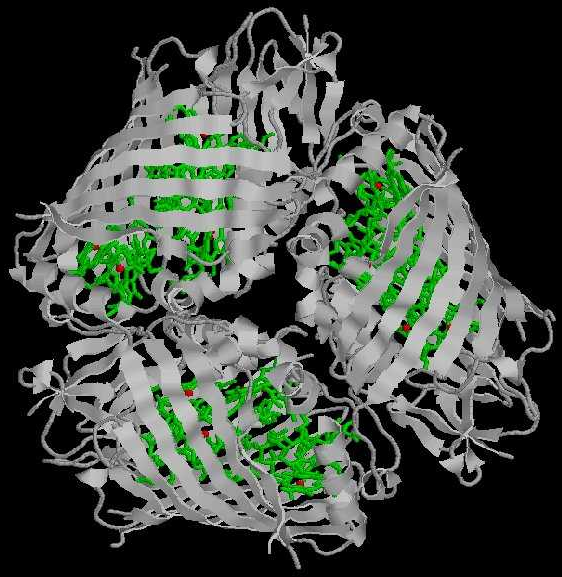Quantum mechanics in photosynthesis
Physicists were able to obtain experimental evidence of the influence of quantum mechanics on the process of photosynthesis. In recent years, a number of observations have been carried out, showing that there are definitely quantum effects there, but now scientists have proven that these effects are really related to energy transfer in cells.
An experiment conducted under the guidance of Greg Engel (Greg Engel) from the University of Chicago and Shaul Mukamel (Shaul Mukamel) from the University of California, showed that the transfer of energy from molecular complexes “antennas” (chlorosomes) to the reaction centers is carried out using the effect of quantum coherence - one of the basic principles of quantum mechanics, which means the presence of the same particle in several places at the same time (with different probability).
Seventy years ago, it was discovered that the excitation of chlorophyll molecules is associated with specific energy transfer routes. Decades later, it was predicted that quantum processes would be involved. In 2007, a group of scientists under the leadership of the same Greg Engel using spectroscopy for the first time obtained direct evidence of quantum coherence in the excitation of chlorophyll molecules throughout the Fenn-Matthew-Olson complex . True, then it was not possible to prove the effect of coherence on energy transfer. Skeptics said it was just a side effect.
The Fenna-Matthew-Olson complex (in the illustration) includes eight bacteriochlorophyll molecules (marked in green), magnesium atoms (red), and a protein environment. This complex provides energy transfer from chlorosomes to the reaction centers.
')

Fenna-Matthew-Olson Complex
During the last experiment, scientists irradiated the molecules with a laser and precisely measured the magnitude of the excitation of each group of chlorophylls, as a result of which they managed to trace the path of energy transfer and detect a clear mathematical relationship between energy transfer and the quantum coherence of chlorophyll molecules. This means that chlorophyll molecules act in concert with each other (quantum information transfer occurs between them), directing energy along the most efficient route. Perhaps this ultimately explains the high efficiency of photosynthesis.
As we see, quantum coupling is possible in living cells at room temperature. Moreover, quantum effects are the basis of life on our planet, given the importance of photosynthesis in the terrestrial biocenosis.
If such bulky molecular structures as Fenn-Matthew-Olson complexes are capable of applying quantum mechanics in their work, then why shouldn't we learn how to do this? According to scientists, if we learn to manage quantum coherence as effectively as plants do, this will be a big step towards creating more efficient solar cells, as well as quantum computers and other devices capable of transmitting information faster than the speed of light.
Experts also suggest that various quantum effects can be found in other biological processes, including cells of the human body. In this regard, some people even talk about the birth of a new scientific discipline - quantum biology.
The results of the experiment of American scientists were published on December 6 in the journal Proceedings of the National Academy of Sciences .
via Wired , Discover
An experiment conducted under the guidance of Greg Engel (Greg Engel) from the University of Chicago and Shaul Mukamel (Shaul Mukamel) from the University of California, showed that the transfer of energy from molecular complexes “antennas” (chlorosomes) to the reaction centers is carried out using the effect of quantum coherence - one of the basic principles of quantum mechanics, which means the presence of the same particle in several places at the same time (with different probability).
Seventy years ago, it was discovered that the excitation of chlorophyll molecules is associated with specific energy transfer routes. Decades later, it was predicted that quantum processes would be involved. In 2007, a group of scientists under the leadership of the same Greg Engel using spectroscopy for the first time obtained direct evidence of quantum coherence in the excitation of chlorophyll molecules throughout the Fenn-Matthew-Olson complex . True, then it was not possible to prove the effect of coherence on energy transfer. Skeptics said it was just a side effect.
The Fenna-Matthew-Olson complex (in the illustration) includes eight bacteriochlorophyll molecules (marked in green), magnesium atoms (red), and a protein environment. This complex provides energy transfer from chlorosomes to the reaction centers.
')

Fenna-Matthew-Olson Complex
During the last experiment, scientists irradiated the molecules with a laser and precisely measured the magnitude of the excitation of each group of chlorophylls, as a result of which they managed to trace the path of energy transfer and detect a clear mathematical relationship between energy transfer and the quantum coherence of chlorophyll molecules. This means that chlorophyll molecules act in concert with each other (quantum information transfer occurs between them), directing energy along the most efficient route. Perhaps this ultimately explains the high efficiency of photosynthesis.
As we see, quantum coupling is possible in living cells at room temperature. Moreover, quantum effects are the basis of life on our planet, given the importance of photosynthesis in the terrestrial biocenosis.
If such bulky molecular structures as Fenn-Matthew-Olson complexes are capable of applying quantum mechanics in their work, then why shouldn't we learn how to do this? According to scientists, if we learn to manage quantum coherence as effectively as plants do, this will be a big step towards creating more efficient solar cells, as well as quantum computers and other devices capable of transmitting information faster than the speed of light.
Experts also suggest that various quantum effects can be found in other biological processes, including cells of the human body. In this regard, some people even talk about the birth of a new scientific discipline - quantum biology.
The results of the experiment of American scientists were published on December 6 in the journal Proceedings of the National Academy of Sciences .
via Wired , Discover
Source: https://habr.com/ru/post/134640/
All Articles